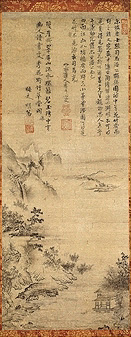

![]()
Pavilion in a Beautiful Field (Shuyado)
Muromachi period, 15th century
Hanging scroll; ink and slight color on paperChinese-inspired "poem-picture" scrolls (shigajiku) gained popularity among Japanese patrons in the fifteenth century. Many works in this tradition are of a celebratory nature and center on the theme of scholarly reclusion. When a study was built, its owner and his guests would gather to name it and compose poetry to commemorate its completion. In this scroll, a study is depicted in a serene and secluded landscape. The inscriptions were written by two Japanese monks in which they appended themselves to a lineage of Chinese scholars by referring to past writings.
The Ideal of the Male Scholar
At a number of periods in its history, Japan looked to China for cultural inspiration. Male-favoring philosophies such as Confucianism were absorbed into Japanese thought, and then further reinforced and normalized in Japan's artistic expression. In China, intellectual life was exemplified by the male scholar-recluse, who withdrew from mundane concerns and devoted himself to quiet study and contemplation. In Japan, this ideal is reflected in works ranging from ink painting to tea ceremony utensils.
